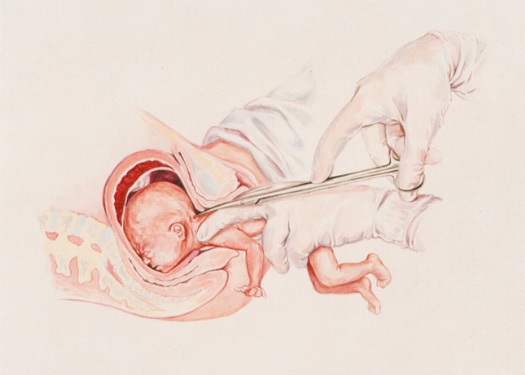An article published by Rolling Stone Magazine indicates that the publication has poorly researched the gruesome method of partial-birth abortion. In the piece published in the magazine, author Bridgette Dunlap falsely claimed that the method was merely “a little-used technique.”
“Partial-birth abortion,” a layman’s term for the procedure known as dilation and extraction, or D&X (as coined by the procedure’s creator, abortionist Martin Haskell), was by no means rare or “little used,” as Dunlap claims. And the procedure was so inhumane that it was eventually outlawed (with an exception for the life of the mother). President Bill Clinton had vetoed a bill that would have outlawed it during his presidency, but in November 2003, President George W. Bush signed the Partial-Birth Abortion Ban Act at last, despite pro-choice political opposition.
The procedure’s creator, Martin Haskell, described the late-term abortion procedure to an audience at a National Abortion Federation Risk Management Seminar on September 13-14, 1992, in Dallas. That audio, which was obtained by the pro-life group Life Dynamics, is disturbing. Some excerpts:
The surgeon introduces a large grasping forceps, such as Bierer or Hern, through the vaginal and cervical canals into the corpus of the uterus. He moves the tip of the instrument carefully towards the fetal lower extremities. When the instrument appears on the sonogram screen, the surgeon is able to open and close the jaws firmly to reliably grasp the lower extremity…The surgeon then applies firm traction causing eversion of the fetus and pulls the extremity into the vagina. By observing the movement of the lower extremity and the eversion of the fetus on the ultrasound screen, the surgeon is assured that his instrument has not inadvertently grasped a maternal structure…The surgeon then uses his fingers to deliver the opposite lower extremity, then the torso, the shoulders, and the upper extremities. The skull lodges in the internal os.The fetus oriented dorsum or spine up.
At this point, the surgeon, the right-handed surgeon slides the fingers of the left hand along the back of the fetus and hooks the shoulders of the fetus with the index and ring fingers…Next, he slides the tip of the middle finger along the spine towards the skull while applying traction to the shoulders and the lower extremities. The middle finger lifts and pushes the cervix out of the way. While maintaining this tension, the surgeon then takes a pair of blunt Metzenbaum scissors in the right hand, he carefully advances the tip curve down along the spine and under the middle finger until he feels it contact the base of the skull, under the tip of the middle finger. Reassessing the proper placement of the closed scissors tip, and safe elevation of the cervix, the surgeon then forces the scissors into the base of the skull. He spreads the scissors to enlarge the opening. The surgeon then introduces a suction catheter into this hole and evacuates the skull contents. With the catheter still in place, he applies traction to the fetus, removing it completely from the patient.
Haskell coined the term “D&X” in order to distinguish the method from the standard D&E method. D&X differs from D&E in that the D&X removes the preborn child intact (Rolling Stone calls partial-birth abortion an “intact D&E”), rather than removing the body parts of the child after she has been dismembered inside the uterus.
 In 1997, the head of the National Coalition of Abortion Providers (NCAP), Ron Fitzsimmons, admitted that he “lied through his teeth” two years earlier when he claimed the procedure was “rare.” He later claimed that approximately 3,000-5,000 partial birth abortions were performed annually, the majority on healthy babies.
In 1997, the head of the National Coalition of Abortion Providers (NCAP), Ron Fitzsimmons, admitted that he “lied through his teeth” two years earlier when he claimed the procedure was “rare.” He later claimed that approximately 3,000-5,000 partial birth abortions were performed annually, the majority on healthy babies.
Fitzsimmons told Nightline:
The majority of these procedures are performed in the late second trimester on healthy women and healthy fetuses. That’s — the law allows that. Women come in at that point unfortunately, for whatever reason, seeking abortion services. We estimate that approximately 3,000 to 5,000 are performed in the United States on an annual basis.
According to the LA Times, the “Washington Post and the Bergen County (N.J.) Record found evidence of thousands of cases of partial-birth abortion usually in the fifth or sixth month of pregnancy, and most involving healthy women and babies. Based on interviews with abortion providers, the Post estimated several thousand partial-birth abortions a year; the Record reported 1,500 in New Jersey alone.”
As one clinic physician told the Record, “Most are Medicaid patients, black and white, and most are for elective, not medical reasons: people who didn’t realize or didn’t care how far along they were. Most are teenagers.”
Slate Magazine (not exactly known for being pro-life), reported that abortion doctors have publicly admitted the electiveness of most partial-birth abortions for years:
Martin Haskell, the Ohio doctor who developed the procedure, asserted in one paper that 80 percent of his patients choose it because it is safer and more convenient than the alternatives. There was no medical necessity. The other leading late-term abortionist, the now-deceased Dr. James McMahon, presented similar statistics before a congressional committee two years ago. These two doctors together performed 500 late-term abortions in one year, and there are at least eight other doctors who administer it–obviously, this adds up to more than 500 IDEs a year nationwide.
In addition, Haskell also stated in his paper that he had performed 700 of the procedures. Three of those procedures were witnessed by a nurse who worked for him temporarily. Her name is Brenda Pratt Shafer, and she testified about what she saw in the first of the three procedures:
The mother was six months pregnant (26 1/2 weeks). A doctor told her that the baby had Down Syndrome and she decided to have an abortion. She came in the first two days to have the laminaria inserted and changed, and she cried the whole time. On the third day she came in to receive the partial-birth procedure.
Dr. Haskell brought the ultrasound in and hooked it up so that he could see the baby. On the ultrasound screen, I could see the heart beating. As Dr. Haskell watched the baby on the ultrasound screen, the baby’s heartbeat was clearly visible on the ultrasound screen.
Dr. Haskell went in with forceps and grabbed the baby’s legs and pulled them down into the birth canal. Then he delivered the baby’s body and the arms– everything but the head. The doctor kept the baby’s head just inside the uterus.
The baby’s little fingers were clasping and unclasping, and his feet were kicking. Then the doctor stuck the scissors through the back of his head, and the baby’s arms jerked out in a flinch, a startle reaction, like a baby does when he thinks that he might fall.
The doctor opened up the scissors, stuck a high-powered suction tube into the opening and sucked the baby’s brains out. Now the baby was completely limp. I was really completely unprepared for what I was seeing. I almost threw up as I watched the doctor do these things.
In all fainess, Rolling Stone writer Bridgette Dunlap’s focus was not specifically partial-birth abortion, which might be why her research was so lacking. Her focus was to discredit vice presidential candidate Mike Pence for statements he made during the vice presidential debate, stating that Pence “tried to portray Kaine and Hillary Clinton as the extremists by claiming they support ‘partial birth abortion.'” But while Democratic vice presidential candidate Tim Kaine has stated that he is “personally pro-life” while “support[ing] Roe v. Wade,” his running mate Hillary Clinton is indeed on record as having argued against banning the partial-birth abortion procedure as a U.S. senator in 2003.
Dunlap finishes her piece by claiming that making early abortion easier for women is what pro-lifers need to do to further their cause… or something: “If Republicans were sincere about eliminating late-term abortion, they’d support making it as easy as possible for a woman to obtain a medication abortion the nanosecond she thinks she’s pregnant. But they don’t actually like very early abortion. Because it’s a threat to the cause.”
Of course pro-lifers “don’t actually like” early abortion. We don’t like abortion. Period.
The fact is that abortion – whether early or late-term – is not a threat “to the cause.” It is a threat to the life of an actual, living human being: the child in the womb.








